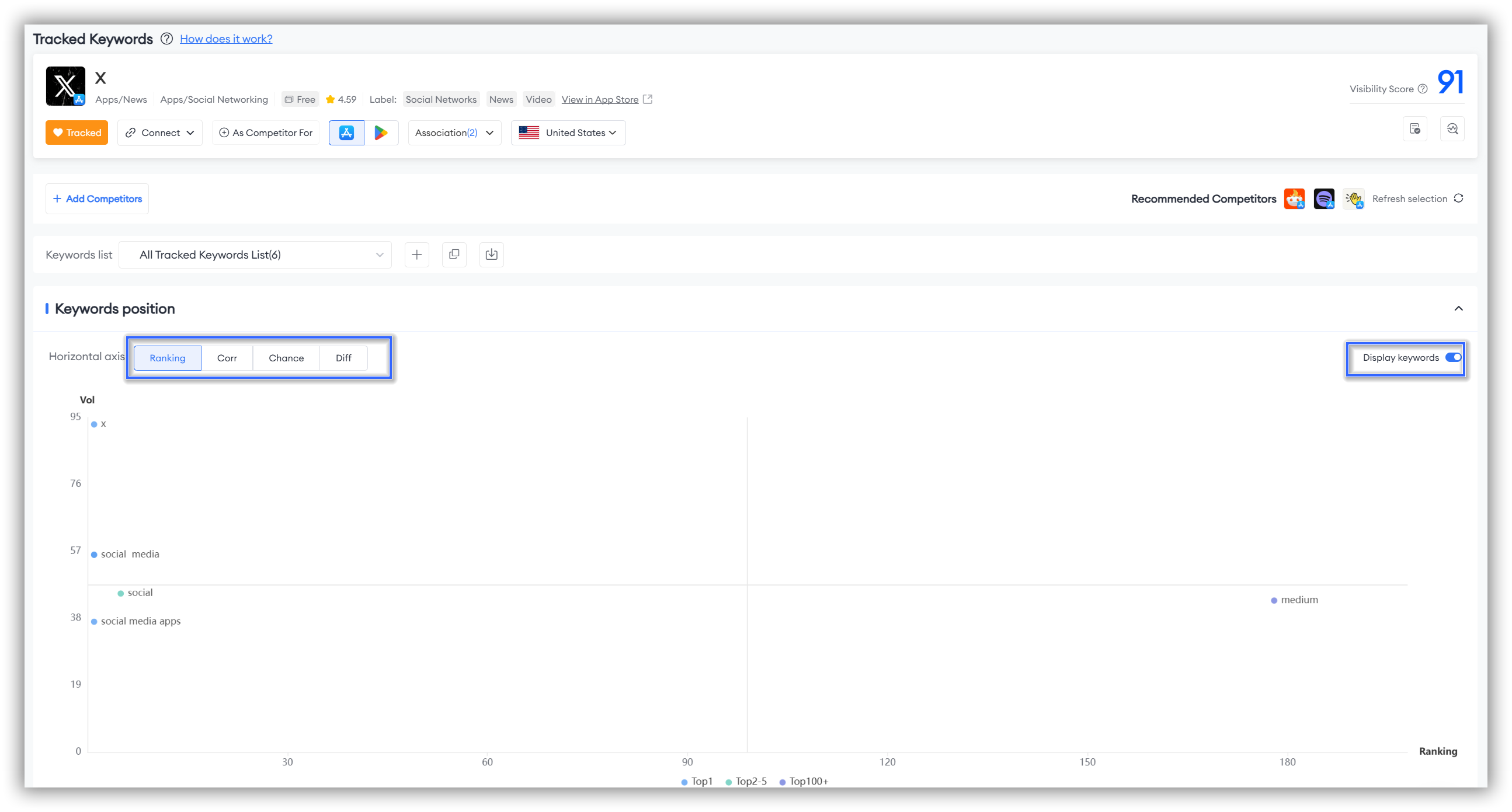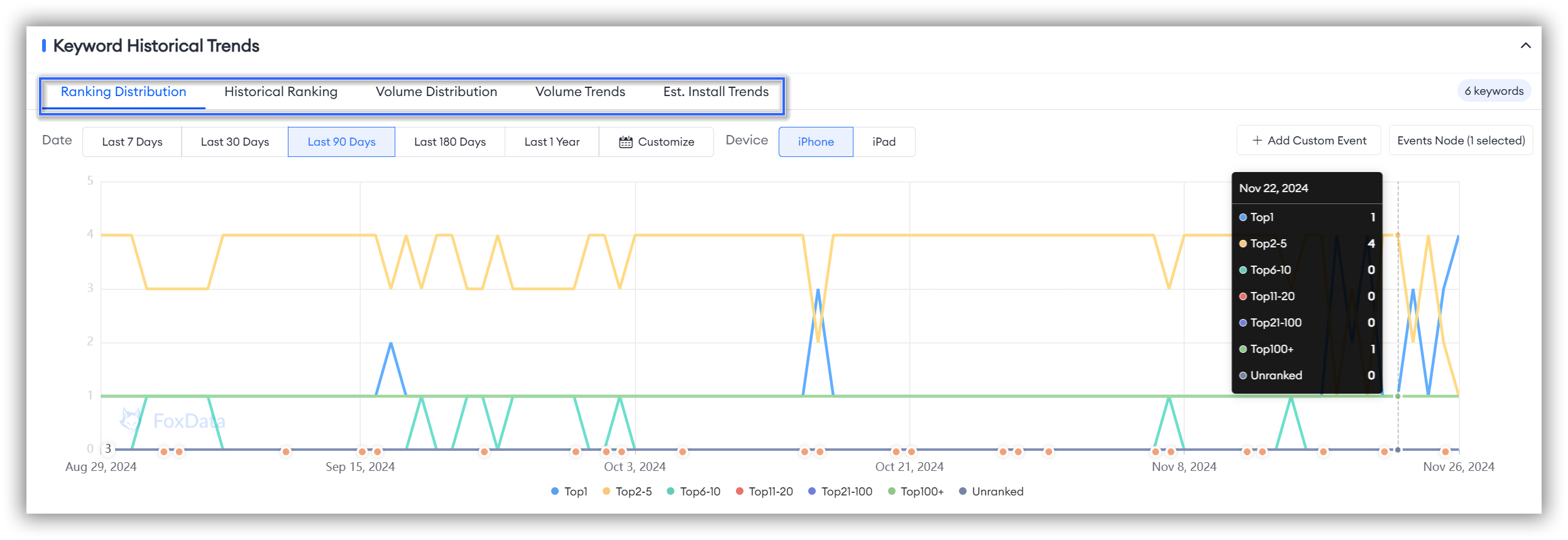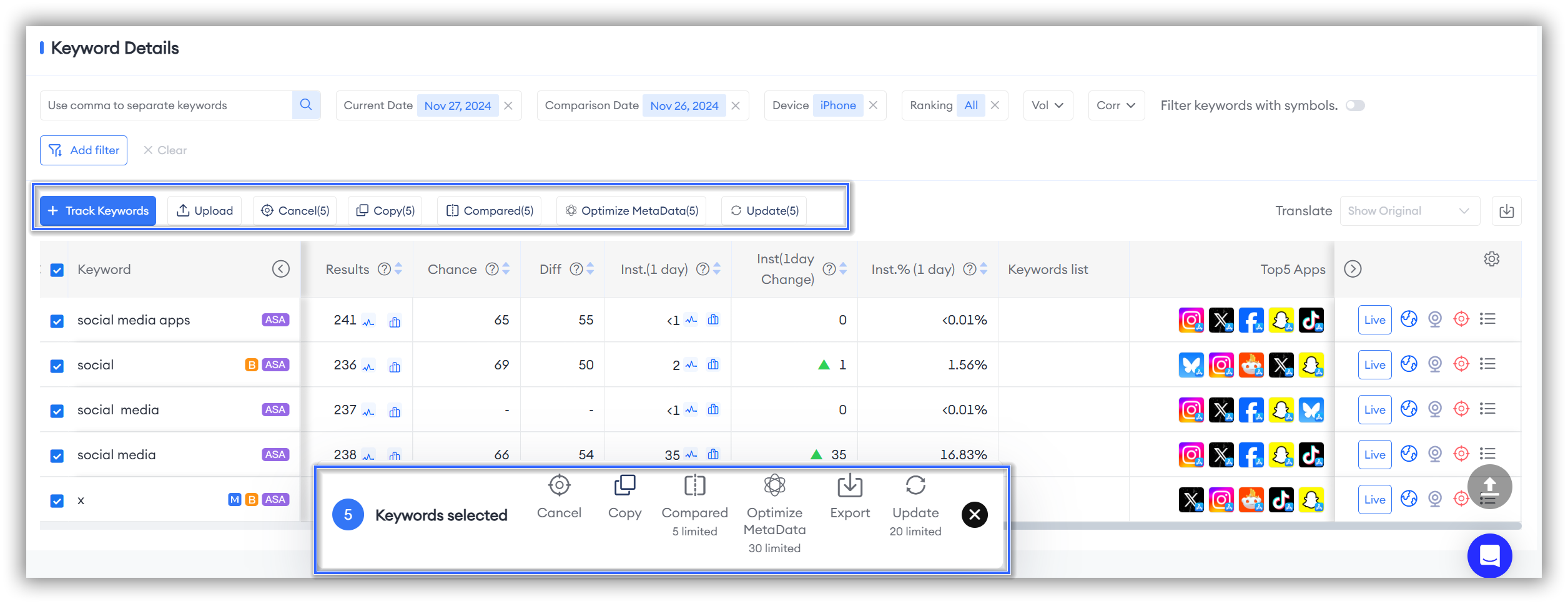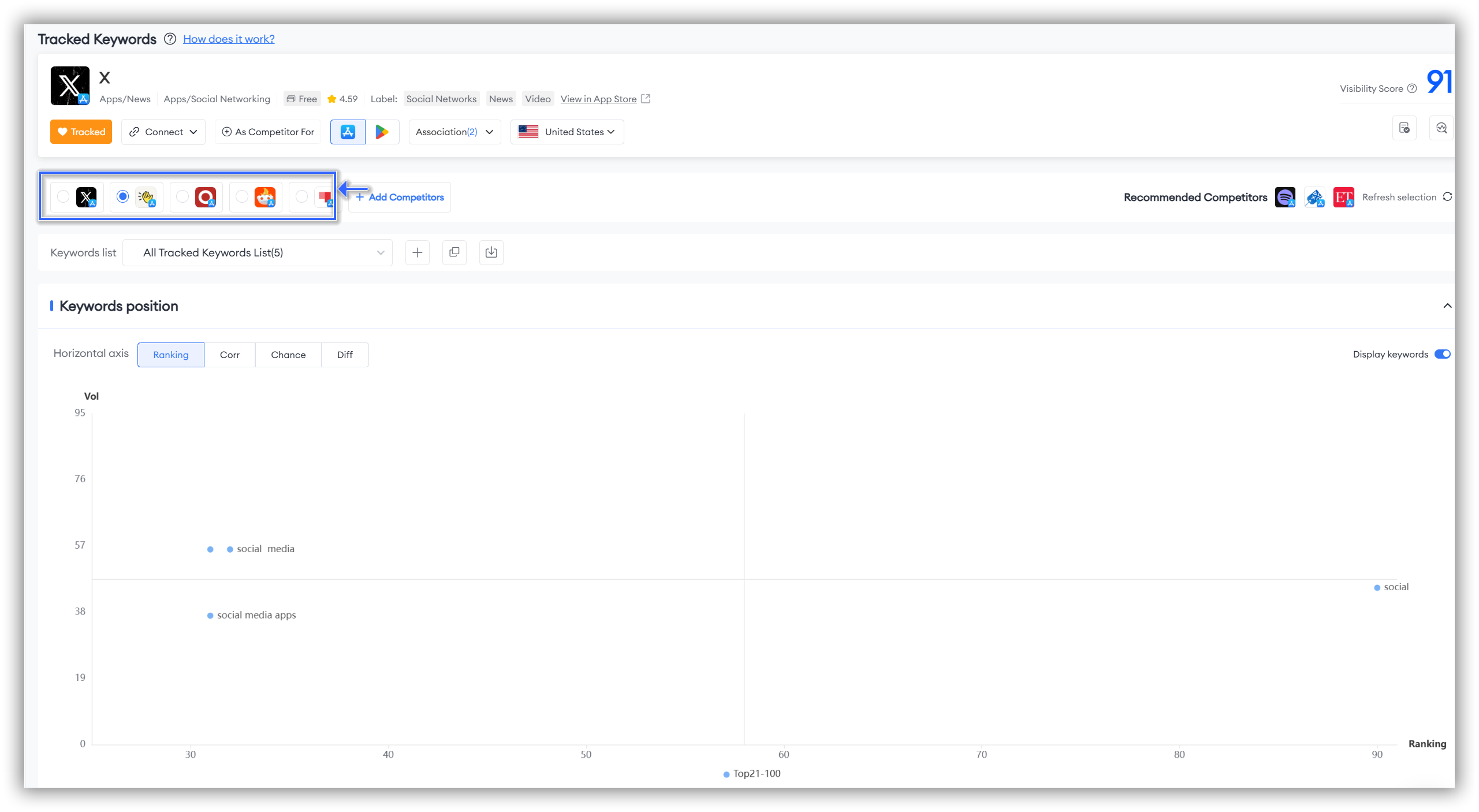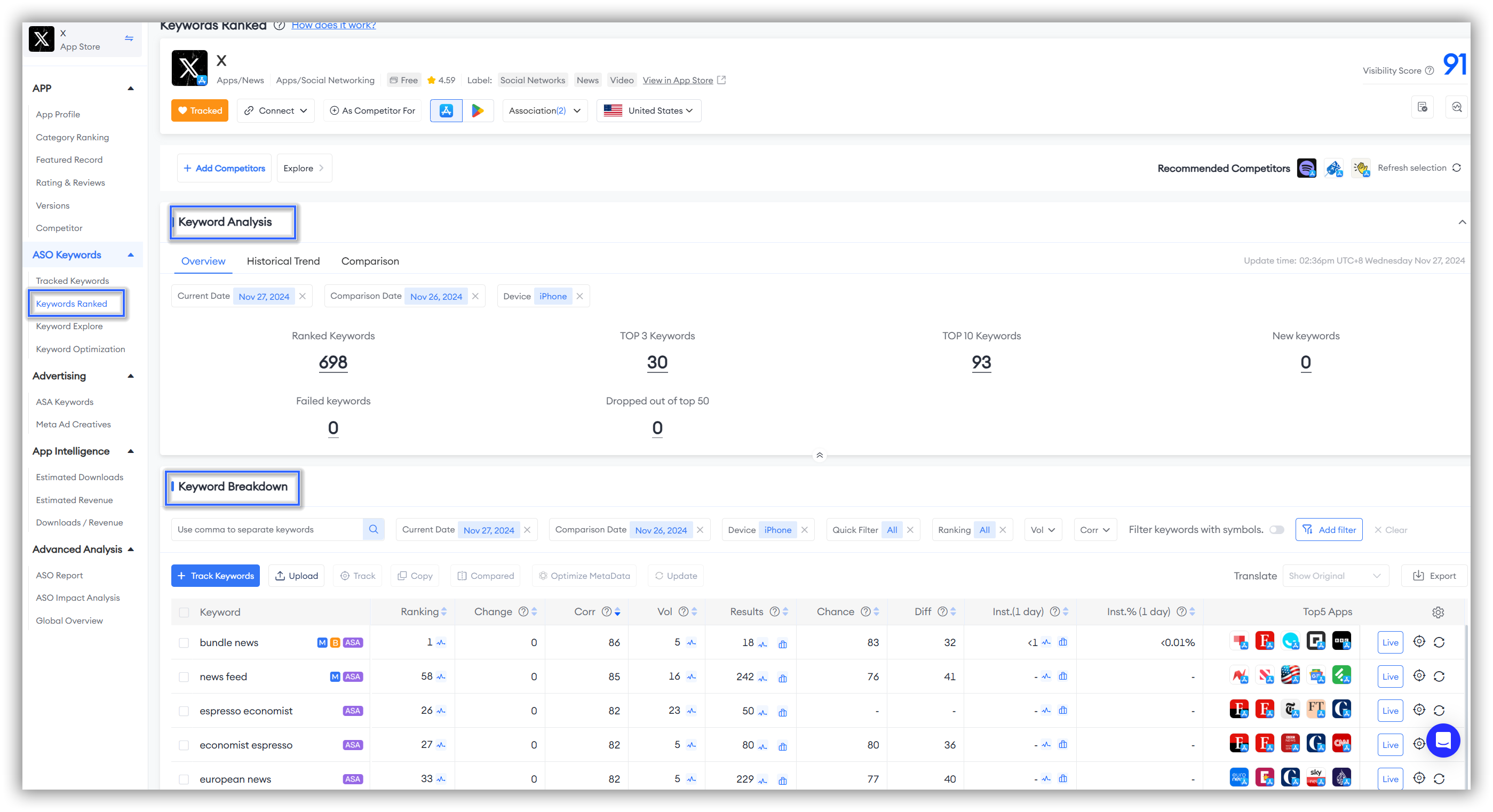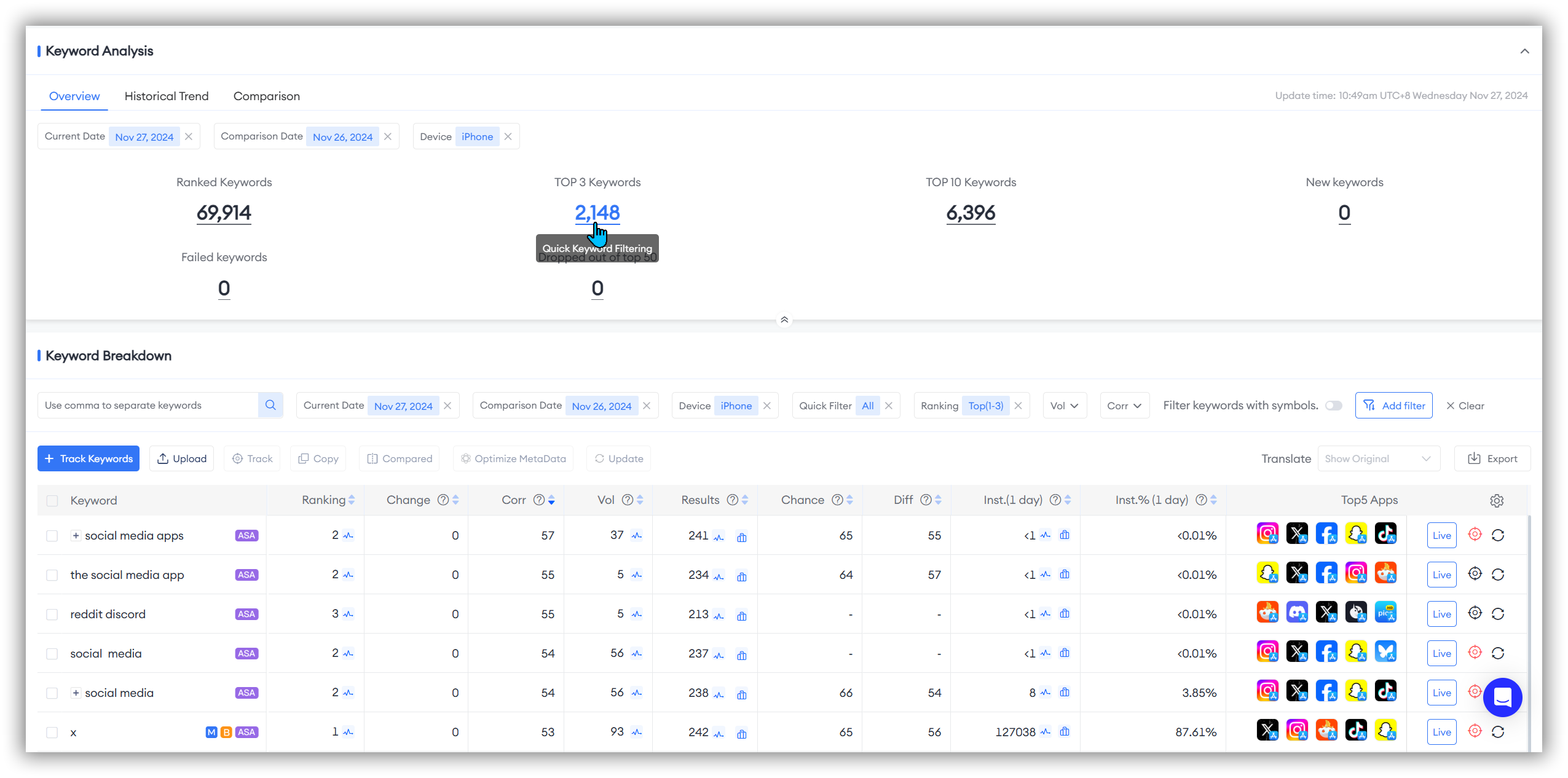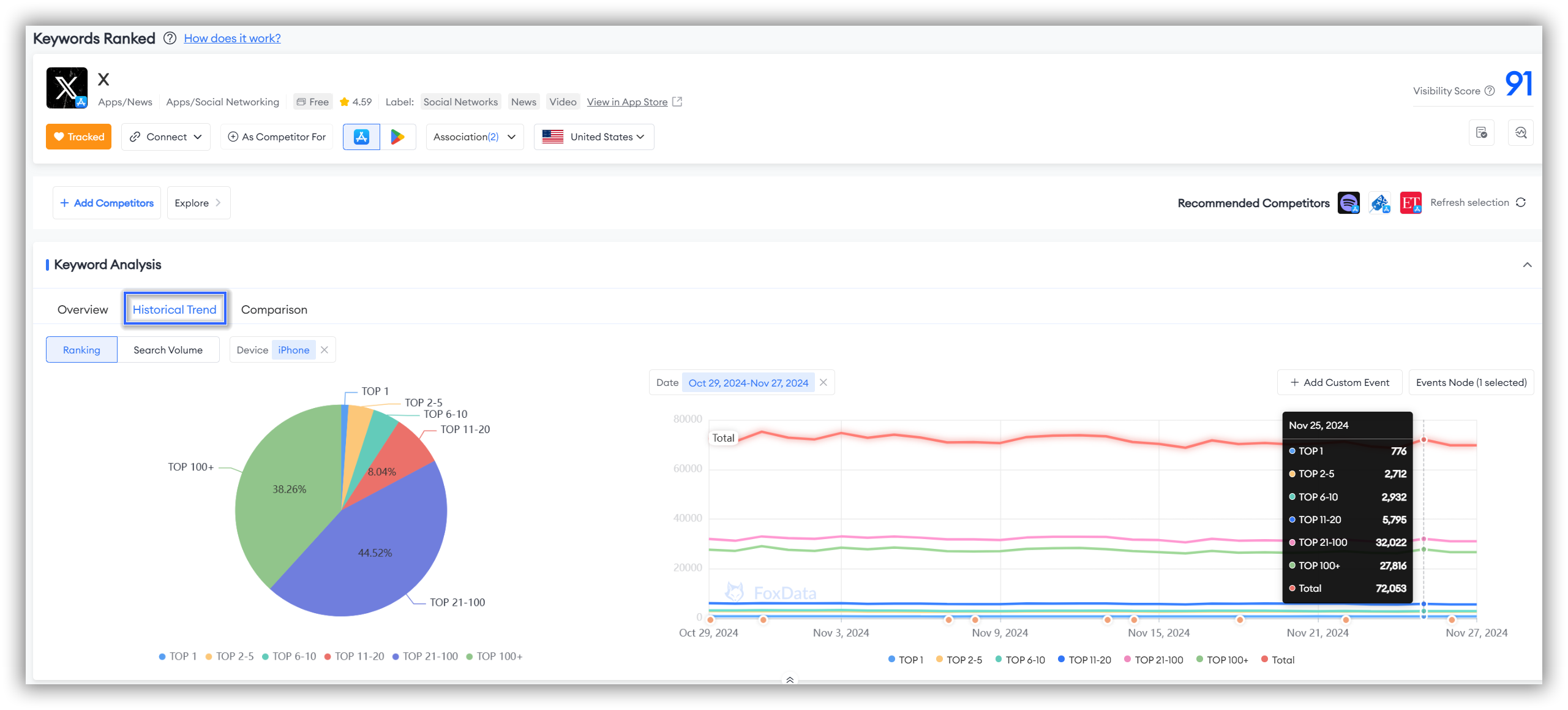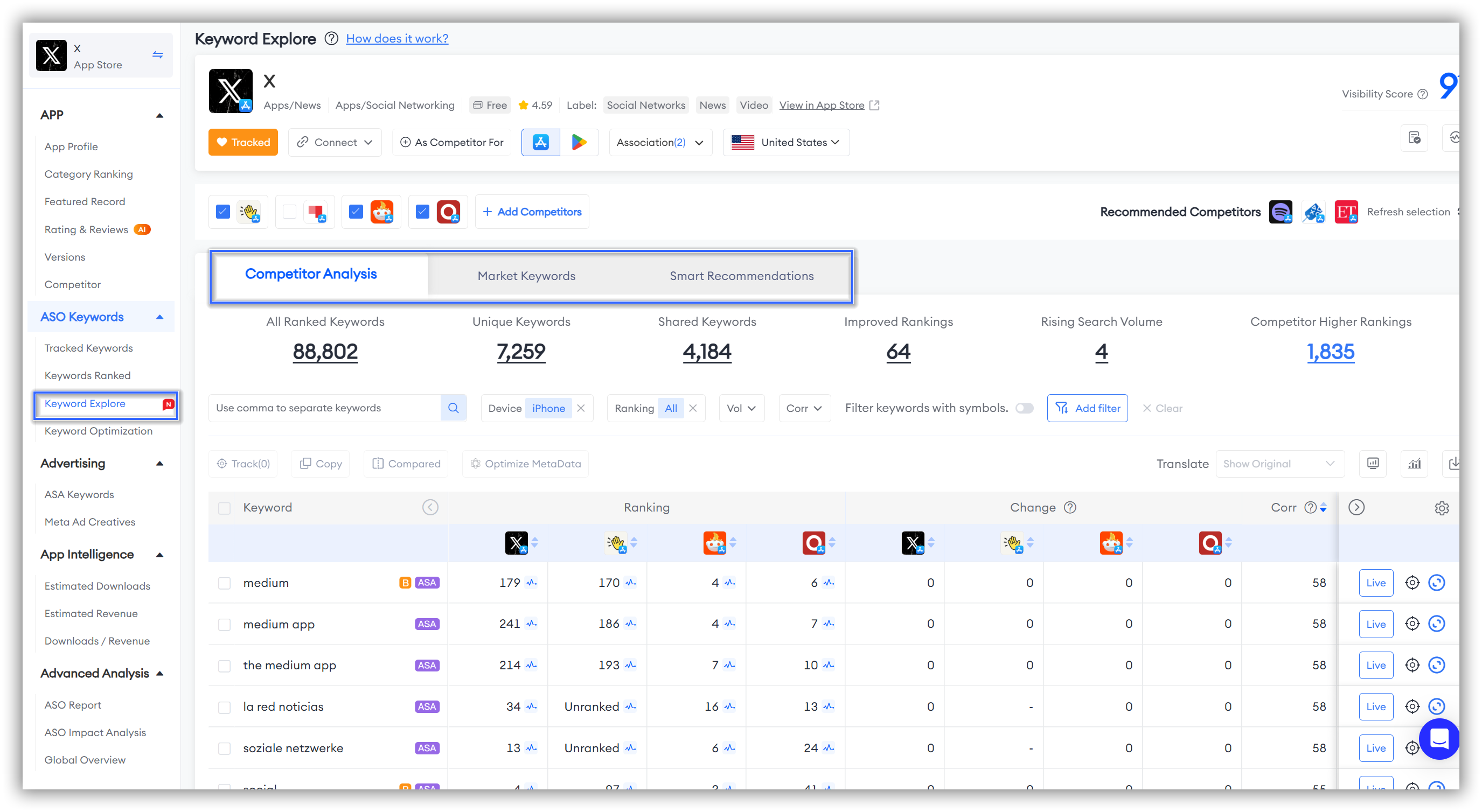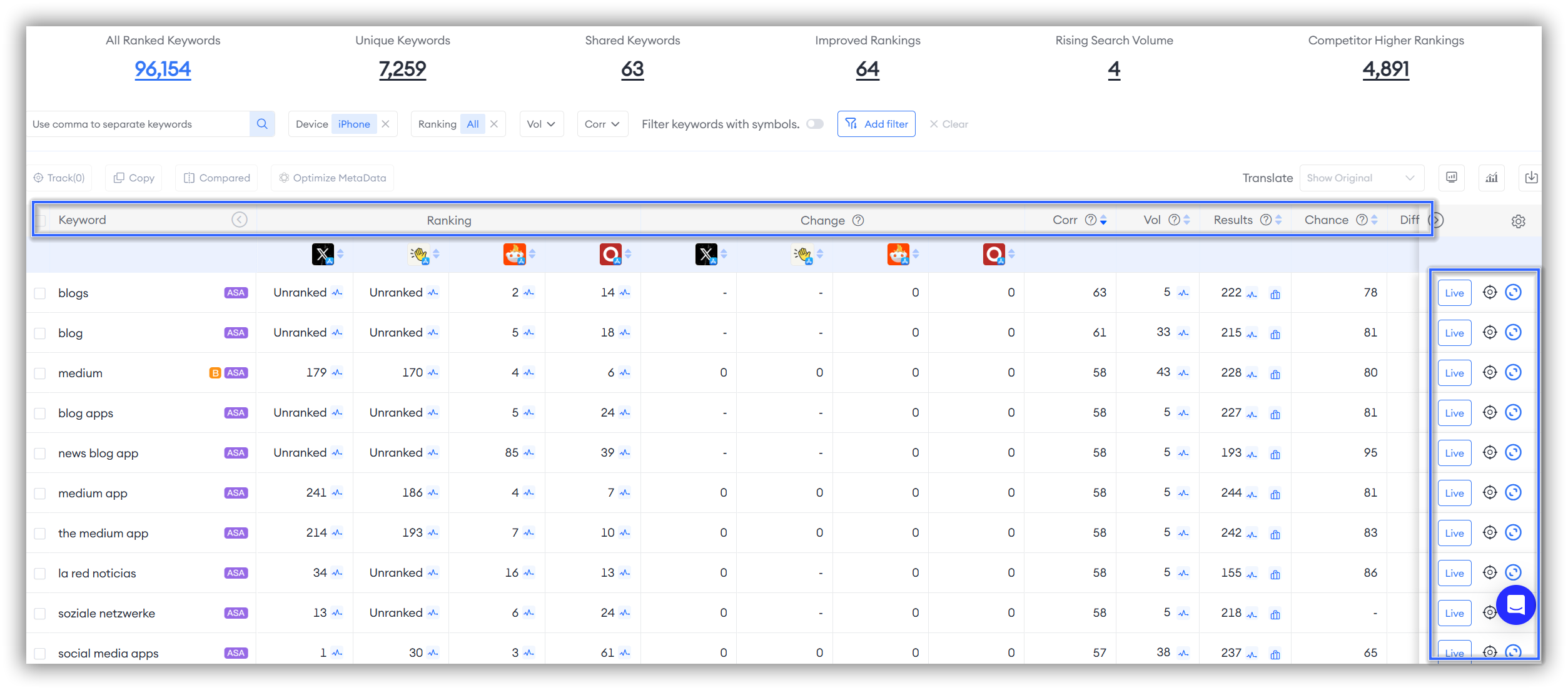Can I customize some filter options according to my needs?
Certainly! You can customize filter options according to your needs. FoxData supports personalized keyword research by allowing you to: Use commas to separate keywords, Filter by "Date", Filter by "Device", Filter by "Ranking", and all other dimensions below the keyword research section
If you wish to filter more keyword dimensions, don't forget to click "Add Filter" in the top left corner.

When you encounter unfamiliar languages during keyword research, FoxData allows you to click the "Translate" button in the top right corner to translate all keywords in the "Keywords Detail" section.
Currently, FoxData supports translations in six languages: Russian, Japanese, Korean, Simplified Chinese, Spanish, and English.
Is there a related competitor keyword comparison chart in "Competitor Analysis"?
Yes, there is! Have you noticed the two chart icons right after the "Translation" button in the top right corner?

- Clicking on the first "computer" icon will provide you with an overview of your competitors' keywords comparison in terms of volumes.
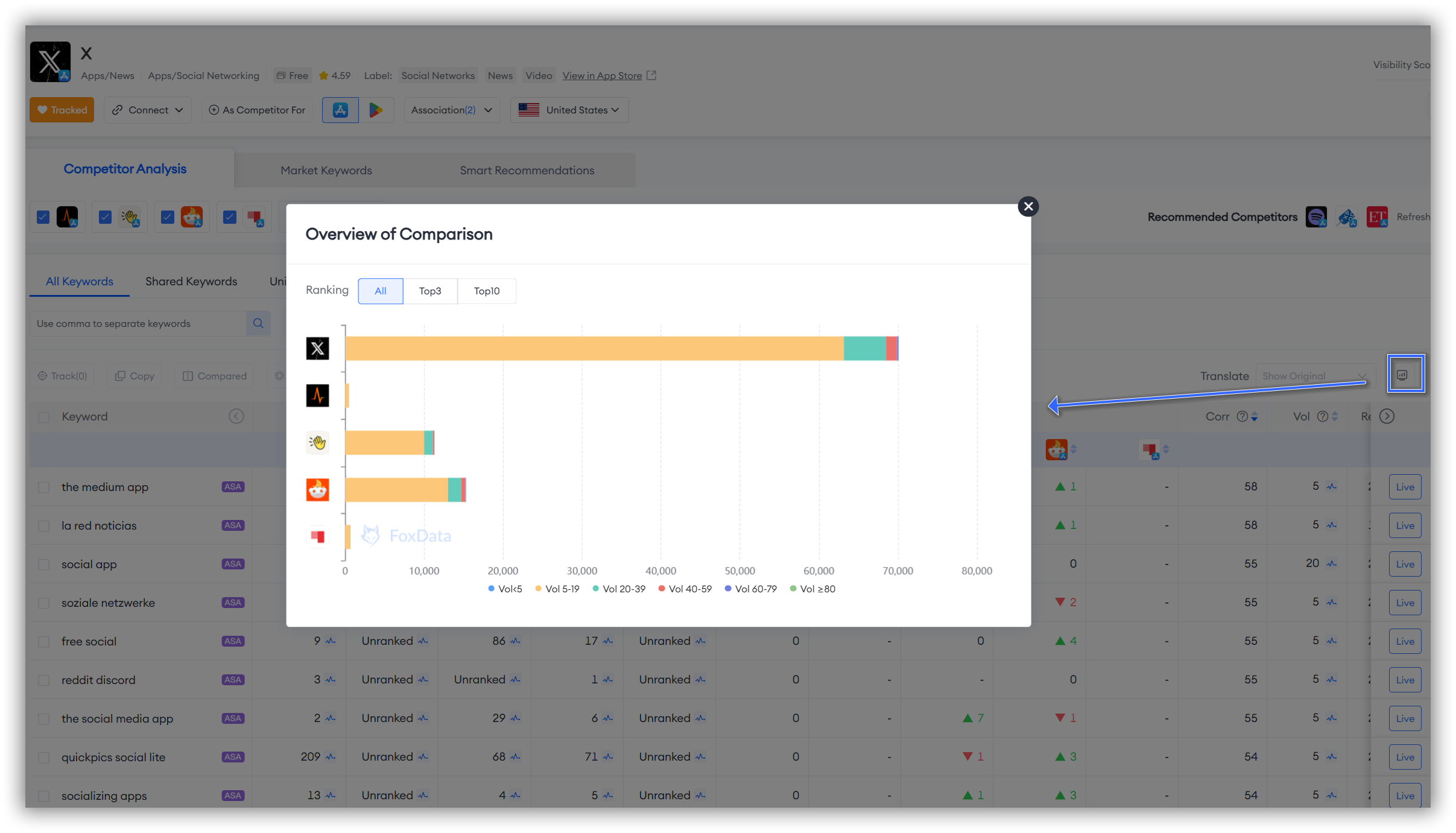
- Clicking on the second "bar and line chart" icon will give you a comparison of your competitors' keywords trend in terms of volumes.

How can I manage or use these keywords?
FoxData allows you to manage and use your selected keywords by clicking on various options like "Track," "Copy," "Compare," "Optimize Metadata," "Export," and "Update" after selecting the keywords you're interested in. This enables personalized keyword usage and management.

Market Keywords
The second section of the "Keyword Explore" feature is "Market Keywords," which will help you gain more keyword suggestions to optimize your ASO keyword strategy.
You have two ways to use the "Market Keywords" section:
- When using the "Competitor Analysis" section, you can click on the last "blue icon" in the final column of the keywords you are interested in. After clicking, you will be redirected to the "Market Keywords" section to get suggestions based on the keywords search result.
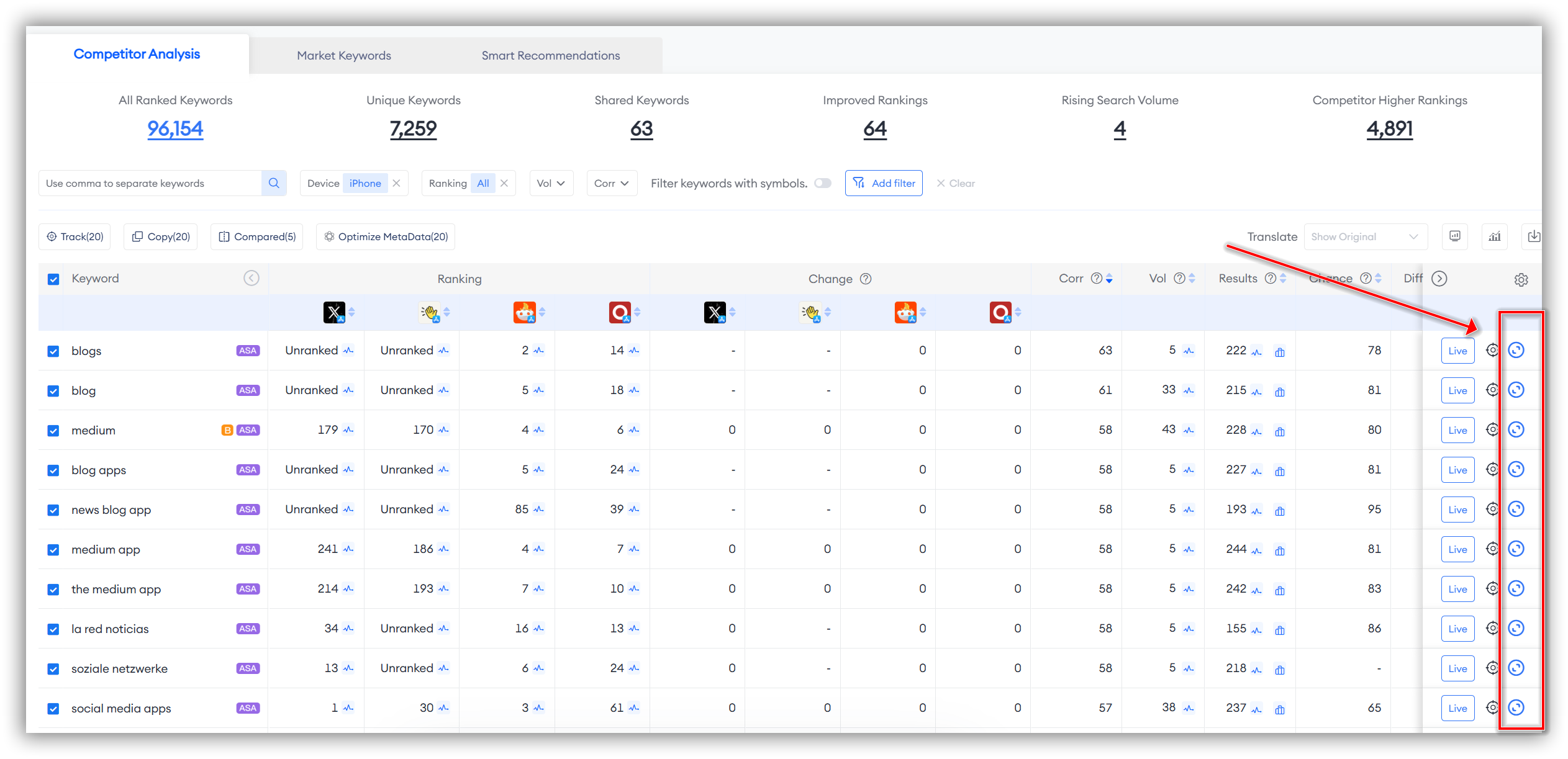
- You can click on the second section, "Market Analysis," under the "Keyword Explore" feature and directly enter the keyword you want to learn more about. After doing so, you will receive extended suggestions based on the search results for that keyword.
 📒 Note: If you use the second method, before you enter your target keywords, you'll also get a carousel display of high-value keywords at the top of the page, along with an overview of keywords in the following three dimensions: "Competitor Keywords," "Market Category Keywords," and "Global Hot Keywords."
📒 Note: If you use the second method, before you enter your target keywords, you'll also get a carousel display of high-value keywords at the top of the page, along with an overview of keywords in the following three dimensions: "Competitor Keywords," "Market Category Keywords," and "Global Hot Keywords."
This can help you find more target keywords for further research.
Additionally, use these keywords to adjust your app to better meet market demands.
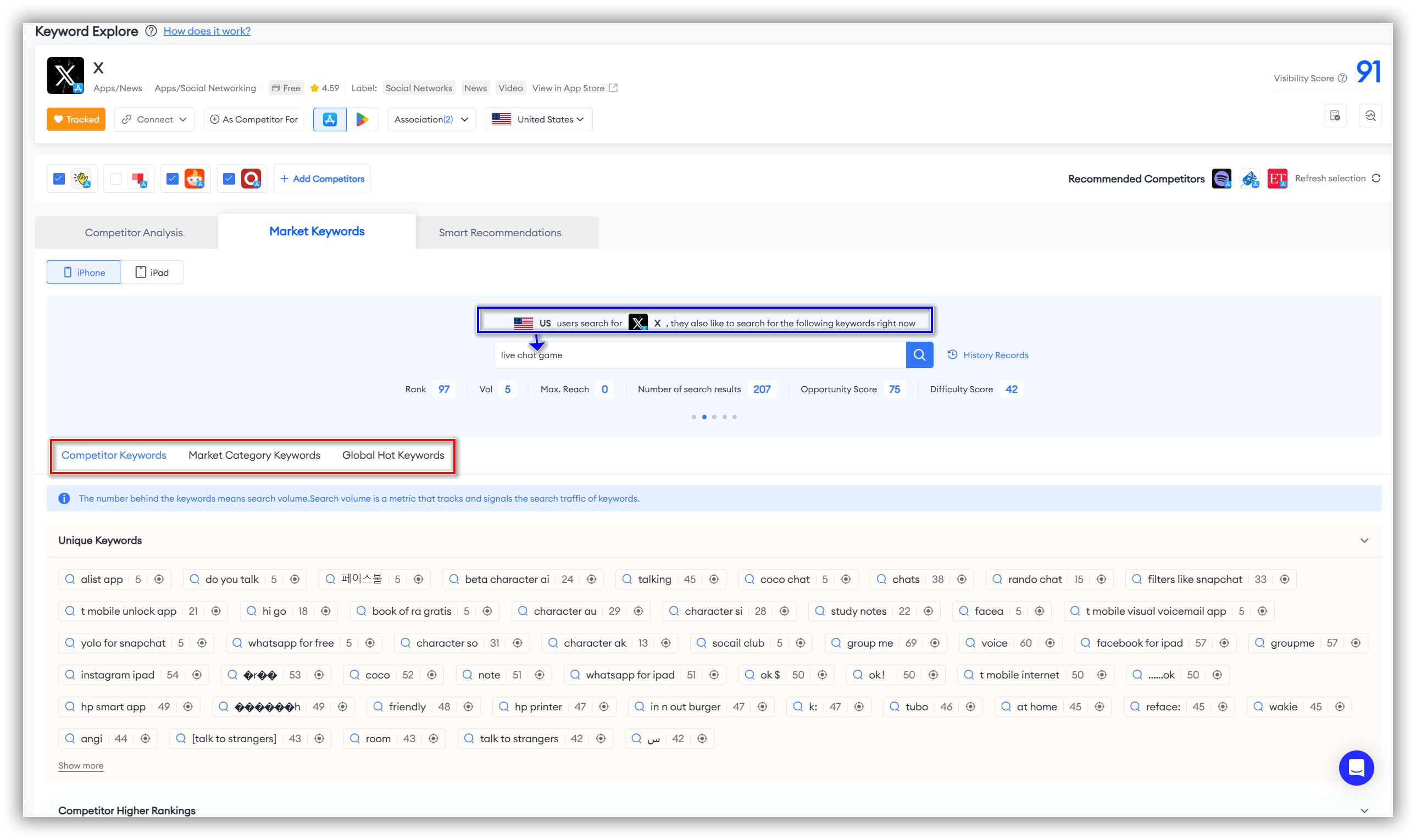 Regardless of the method you use, once you successfully enter the "Market Keywords" section, you can view related "Top App Keywords," "Categorized Keywords," and "Long-tail Keywords" based on the word you searched for.
Regardless of the method you use, once you successfully enter the "Market Keywords" section, you can view related "Top App Keywords," "Categorized Keywords," and "Long-tail Keywords" based on the word you searched for.

Top App Keywords
"Top Keywords" allows you to discover keywords related to top apps that are closely linked to your searched keyword.
This helps you understand the high-frequency keywords associated with your target keyword. These keywords are often searched frequently in app stores, providing inspiration for optimizing your App Store Optimization (ASO) strategy.
📒 Note: Do not forget to select an app and click the dropdown arrow on the right to uncover similar popular keywords.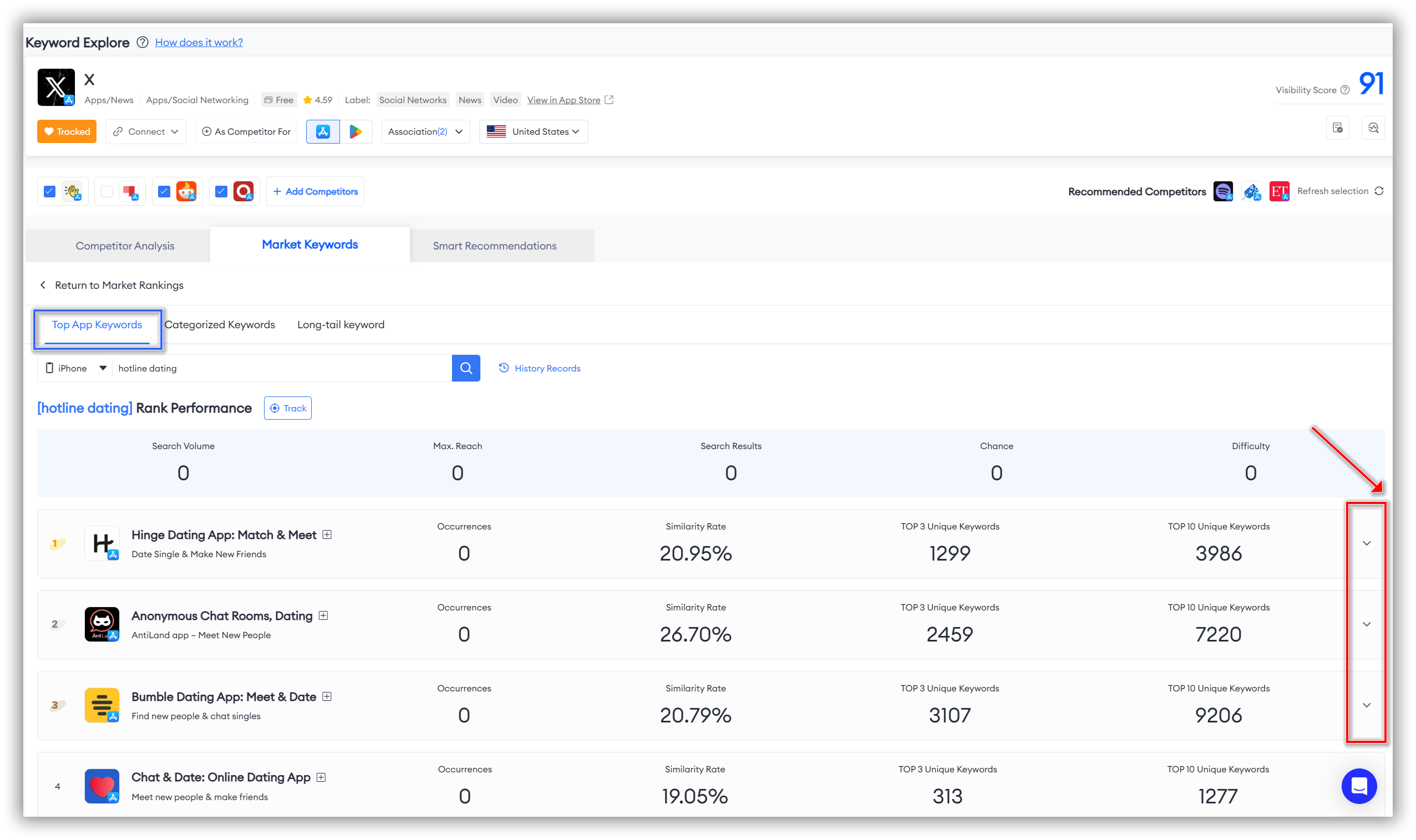
👏 Expert Tips: When using "Top Keywords," we recommend selecting "Compare with my apps" simultaneously. This will help you more comprehensively filter and evaluate high-frequency keywords.
You may discover important keywords that are missing from your app's keyword strategy but have potential value for your app. This insight allows you to adjust and optimize your keyword strategy effectively.
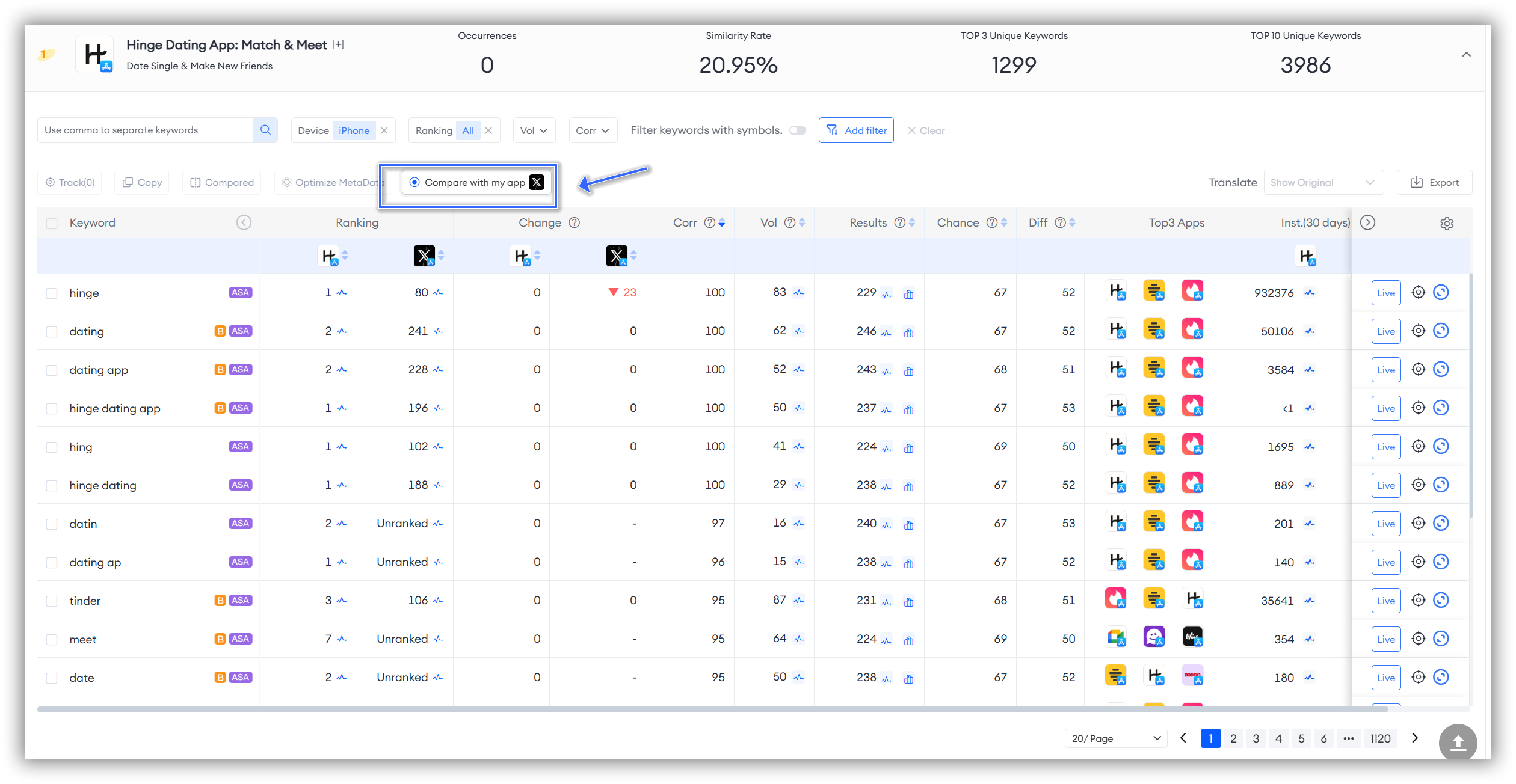
"Top Keywords" supports analyzing keywords from multiple dimensions, including "Ranking," "Ranking Change," "Correlation," "Volume," "Results," "Chance," "Difficulty," "Top 3 Apps," and "Installation."
📒 Note: If you are unclear about the definition of any dimension, please check the "?" icon next to the text of each dimension. It will explain the definition of each dimension.
In addition to the above dimensions, FoxData also allows you to click the "Live" icon in the last column of the keyword to view each keyword's "Live Search Insights." This will help you better understand its real-time value in the app market.
You can also click the "target" icon to track or cancel a keyword.
Notably, "Competitor Analysis" has a unique blue icon in the last column of the keywords. Clicking it allows you to further explore suggestions based on the keywords searched.

Can I customize some filter options according to my needs?
Of course you can! FoxDta allows you to personalize your keyword research by using options like "Use comma to separate keywords", filtering by "Date", "Device", "Ranking", and other dimensions listed below.
If you want to filter by more keyword dimensions, don't forget to click "Add Filter" in the top left corner.

When you encounter unfamiliar languages during keyword research, FoxData also supports translating all keywords in the "Keywords Detail" section by clicking "Translate" in the top right corner.
Currently, FoxData offers translations in six languages: Russian, Japanese, Korean, Simplified Chinese, Spanish, and English.
How can I manage or use these keywords?
After selecting the keywords you are interested in, FoxData allows you to manage and use them by clicking on various options above or below, such as "Track", "Copy", "Compare", "Optimize Metadata", "Export", and "Update" for personalized keyword management and usage.

Categorized Keywords
"Categorized Keywords" helps you understand the most popular keywords within the category related to your keyword.
These are typically the terms most commonly used by users during searches, providing valuable insights for optimizing your product or content.
When using "Categorized Keywords," remember to filter by more specific "app category" and "Lable" according to your needs. This will assist you in finding more relevant and valuable keywords.

📒 Note: For information on the data dimensions, filter options, and management methods related to keywords in the "Categorized Keywords" section, please refer directly to the "Top Keywords" section above.
Long-tail Keywords
"Long-tail Keywords" aids in identifying more precise and targeted search phrases, which typically encounter less competition.
📒
Note: For information on the data dimensions, filter options, and management methods related to keywords in the "Long-tail Keywords" section, please refer directly to the "Top Keywords" section above.
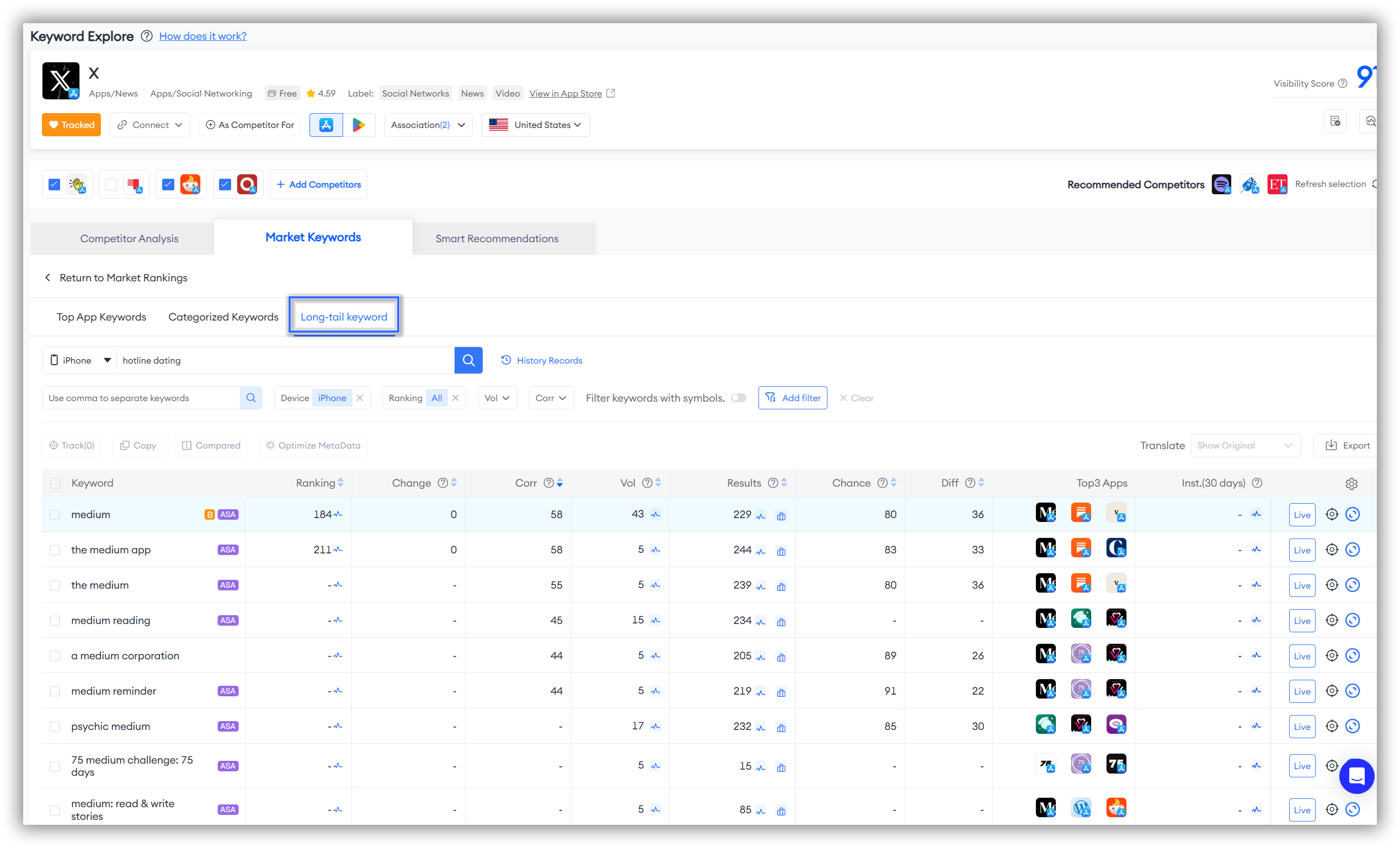
Smart Recommendations
The third section of the "Keyword Explore" feature is "Smart Recommendations." This powerful tool enhances app store optimization efficiency and effectiveness by automatically identifying and recommending high-performing keywords related to your app, helping developers discover keywords they might not have considered.
"Smart Recommendations" allows you to analyze keywords from multiple dimensions: "Ranking," "Correlation," "Volume," "Results," "Chance," "Difficulty," "Installation," and "Installation%."
📒 Note: If you're unclear about the definition of any dimension, please check the "?" icon next to each dimension's text, which explains the definition.
In addition to all the above dimensions, FoxData also allows you to click the "Live" icon in the last column of the keywords to view each keyword's "Live Search Insights," helping you better understand its real-time value in the app market.
You can also click the "target" icon to track or cancel keywords.
Notably, the "Competitor Analysis" section has a unique blue icon in the last column of the keywords. Clicking it will take you to "Market Keywords" to get suggestions based on keywords searched.
📒 Note: For information on the filtering options and management methods for keywords in the "Smart Recommendations" section, please refer directly to the "Market Keywords-Top Keywords" section above.

👏 Expert Tips: If the term you're searching for shows no long-tail keywords or if you want to search for other target keywords, FoxData supports you in directly searching or finding new target keywords from the "Competitor Hot Keywords" and "Market Category Hot Keywords" suggestions to search for related long-tail keywords.

"Keyword Optimization" is the fourth feature of "ASO Keywords," and it includes "Metadata Simulator," "Analysis Suggestions," and "Keyword List."
"Keyword Optimization" helps you accurately select and optimize keywords in the app store, enhancing your app's search ranking.

Metadata Simulator
The "Metadata Simulator" tool on the left helps you simulate and preview the effects of metadata, ensuring your keywords are optimally displayed and ranked in the app store.
In the "Metadata Simulator," you can select your desired keywords from the "Tracked Keywords List" you built using the "Keywords Ranked" and "Keyword Explore" sections above. You can then embed these keywords into your "Title," "Subtitle," and "Keywords" to modify them accordingly.

After making your modifications, don't forget to click the "Start Analysing" button at the bottom.
You will receive a "Keywords Summary" and "Keyword List" analysis on the right side, related to your recent draft.

Analysis Suggestions-Draft-Keywords Summary
The system initially defaults to displaying an overview of keyword changes across the following five dimensions.
If you're interested in the data for a specific dimension, simply click the "up arrow" or "down arrow" to view detailed change data for that dimension.

Want to see more intuitive data changes through images?
Click the "scatter plot" icon in the top right corner to get a more visual representation of the changes in the "Draft." This will help you quickly assess and optimize your strategy.

![]() 📒 Note: FoxDta allows you to perform more personalized filtering on the four-quadrant chart to meet your keyword optimization needs.
📒 Note: FoxDta allows you to perform more personalized filtering on the four-quadrant chart to meet your keyword optimization needs.

Analysis Suggestions-Draft-Keyword list
After reviewing the overview of keyword changes following the "Draft" changes, if you wish to conduct a deeper analysis on specific keywords, simply scroll down to view the "Keywords List."
The "Keywords List" allows you to personalize your filtering based on "Keyword Type," "Status," and "Text Metadata." This enables a more in-depth, personalized analysis of the draft generated in the "Metadata Simulator," helping you optimize your Text Metadata.

Analysis Suggestions do support viewing the analysis of the original Text Metadata.
Of course!
Analysis Suggestions-Current
You can directly click "Current" below the Analysis Suggestions in the top left corner to switch from "Draft" to "Current."
If you are using this feature for the first time and have not used the "Metadata Simulator" to create a draft, clicking into the "Keyword Optimization" feature page will directly display data related to "Current."
📒 Note: FoxDta allows you to perform more personalized filtering on the four-quadrant chart to meet your keyword optimization needs.

Keyword list-Current
After reviewing the overview of keyword changes in "Current," if you wish to conduct a deeper analysis on specific keywords, simply scroll down to view the "Keywords List."
The "Keywords List" allows you to personalize your filtering based on "Keyword Type" and "Text Metadata." This enables a more in-depth understanding of the performance of your current keywords in Text Metadata.

👏Expert Tips:After reviewing the "Current" Analysis Suggestions and Keyword List, our ASO experts recommend using this feature to conduct a competitive "Text Metadata" comparison analysis. This will help you identify valuable or high-potential keywords used by competitors and evaluate their effectiveness and situation in Text Metadata. This will provide you with valuable insights to adjust your own keyword strategy.
You can directly select up to two apps for comparison analysis at the top of the page.
📒 Note: Don't forget to apply your personalized filters in the "Analysis Suggestions" and "Keywords List" to obtain more precise and comprehensive data.

What is the value of "ASO Keywords"?
The value of the "ASO Keywords" tool lies in its comprehensive approach to enhancing App Store Optimization (ASO) strategies. It offers four key features—"Tracked Keywords," "Keywords Ranked," "Keyword Explore," and "Keyword Optimization"—that provide robust support for keyword research, ultimately boosting your app's visibility:
1. ASO Keyword Decision Optimization
Precise Decision-Making: Through the "Tracked Keywords" and "Keywords Ranked" features, developers can monitor and evaluate keyword performance in real-time. This data-driven analysis helps developers make more accurate keyword choices, optimizing app rankings in the app store.
Increased ROI: By optimizing keyword decisions, developers can improve their app's organic search rankings, thereby reducing user acquisition costs and increasing return on investment.
2. Competitive Analysis
Market Insights: The "Keyword Explore" feature allows developers to discover the keywords used by competitors and analyze their strategies. This helps identify market trends and opportunities, giving developers an edge in the competition.
Differentiation Strategy: By understanding competitors' keyword rankings and optimization strategies, developers can craft a differentiated keyword strategy to enhance their app's market competitiveness.
3. Enhanced App Visibility
Comprehensive Optimization: With the "Keyword Optimization" feature, developers can ensure effective integration of keywords in app metadata, enhancing app visibility in search results.
Wider Reach: By exploring and optimizing more relevant keywords, developers can attract a broader user base, increasing app downloads and user engagement.
4. Continuous Improvement and Innovation
Dynamic Adjustment: As markets and user behaviors constantly change, the ASO Keywords Tool provides real-time data and analysis, helping developers continuously optimize and adjust their keyword strategies to adapt to market changes.
Innovation Driven: By consistently exploring new keywords and optimization strategies, developers can maintain innovation and continuously improve their app's market performance.
The ASO Keywords Tool not only provides strong support for keyword research but also enhances market performance and competitiveness through optimized decision-making and competitive analysis.
FAQs
Q: What is the main purpose of the "ASO Keywords" feature?
A:The ASO Keywords Tool is a comprehensive solution designed to enhance App Store Optimization (ASO) strategies. ASO Keywords Tool is valuable for improving your app's visibility and performance in app stores by providing comprehensive keyword analysis and optimization strategies.
Q: How can I most effectively use the four features of this section to complete my ASO keyword research?
A: Our ASO experts recommend that you first look at
"Keywords Ranked" while using "ASO Keywords" to gain a basic understanding of the app you're tracking. Then, explore and build your keyword list with
"Keyword Explore." Next, study the keywords you're tracking or confirm your keyword list in
"Tracked Keywords." Finally, optimize your keywords and text metadata in
"Keyword Optimization." This order facilitates a smoother process for conducting ASO keyword research.
Q: If I don't use the "Keyword Optimization-Metadata Simulator," can I still view the data for "Analysis Suggestions" and the "Keyword list"?
A: Of course! You can directly use "Analysis Suggestions" and the "Keyword list" to view the "Current" data for the app you are tracking. If you use the "Keyword Optimization-Metadata Simulator," you can also see the performance data for your optimized "Draft."
Q: Can I directly conduct competitor research using "ASO Keywords"?
A:The four key features of "ASO Keywords"—"Tracked Keywords," "Keywords Ranked," "Keyword Explore," and "Keyword Optimization"—all support you in conducting competitor research. If you're unsure how to perform competitor research using "ASO Keywords," click
here to access the tutorial.
Q: Is there a tutorial on how to use the "ASO Keywords" feature?
A: Yes, FoxData offers comprehensive tutorials and support documentation to help you make the most of the ASO Keywords feature. You can find them in FoxData blogs or help center.
 Keywords Research
Keywords Research  Reviews Management
Reviews Management  User Activity Monitoring
User Activity Monitoring  User Retention Analytics
User Retention Analytics  Global Market Research Top Charts
Global Market Research Top Charts  Trending Apps Bidding Keyword Analysis Ad Creatives Analysis AI App Marketing
Trending Apps Bidding Keyword Analysis Ad Creatives Analysis AI App Marketing  Keyword Tools Rating & Reviews Tools App Marketing Research Store Insights Est. App Downloads Est. App Revenue App Data Analysis
Keyword Tools Rating & Reviews Tools App Marketing Research Store Insights Est. App Downloads Est. App Revenue App Data Analysis 








